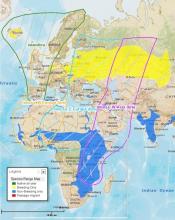A Species Under Threat

 General information
General information
The Black-tailed Godwit (Limosa limosa) is a large wader species. It has a long straight bill and long legs. Its size is around 40 cm. Its wingspan reaches 70 cm. In summer especially males have an orange-brown head, neck and crest. Flanks and belly are covered with brownish spots and stripes. Females most of the time are more dull coloured. When flying, the Black-tailed Godwit can easily be recognised by its white wing bars. Black-tailed Godwits can reach an age of ten to fifteen years, rarely even more than 25 years. In many countries the Black-tailed Godwit breeds in meadows, together with other species like Lapwing, Redshank and Meadow Pipit. Small populations are breeding in mires and bogs. In late summer and early autumn the Black-tailed Godwits are leaving the breeding areas towards their wintering grounds in Southern Europe or Africa. They will return to their breeding grounds in early spring.
Status
The Black-tailed Godwit is listed as Near Threatened on the IUCN World List, and as Vulnerable on European scale by Birdlife International.
Population
The Black-tailed Godwit has a widespread but disjunctive distribution in the Palaearctic, extending from Iceland across northern Europe to western Siberia. Two subspecies occur in Europe. The main breeding range of the nominate form L. l. limosa (110.000 pairs) ranges from The Netherlands to Germany, Poland, Belarus, Ukraine and western Russia. Small populations occur in other European countries. Today about half of the population breeds in The Netherlands. Other significant populations occur in Germany, Russia, Ukraine, Poland and Belarus. Historical data suggest that this population increased during the 20th century, in particular in The Netherlands and NW-Germany, to reach a maximum population size between c.1940 and 1960. Throughout much of its range, this population has been in strong decline since then. The nominate race winters predominantly in open freshwater and brackish habitats in southern Europe and West-Africa south of the Sahara
The subspecies L. l. islandica breeds mainly in Iceland, and increased its breeding range and population over the last 100 years, especially between 1960 and 1990. This increase still goes on. The current population is c. 25.000 pairs. The Icelandic Black-tailed Godwit winters in estuarine habitats along the Atlantic coast from Britain south to Morocco.
Ecology and breeding period
The Black-tailed Godwit is a fully migratory species. It migrates from a broad zone in the northern part of Europe towards the wintering grounds. Three main different routes can be distinguished (see figure). A fourth route (towards unknown wintering grounds in East Africa) is yet not that clear. In winter, the Black-tailed Godwit feeds on rice grains. In fresh/brackish water systems it feeds on all kind of small animals.
The Black-tailed Godwits arrive around March at the breeding grounds. In the breeding areas Black-tailed Godwit occur in both meadows as in mires and bogs. The nesting period is from end of March until end of June. Breeding takes about 25 days. The normal clutch size is 4 eggs. The adults feed on small animals like worms, insects and larvae. Young chicks start feeding on very small insects. After some time they change towards bigger insects and worms too. Moulting starts just after the breeding season. Shortly afterwards they leave the breeding grounds towards their wintering areas.
Trends
In recent decades, the North-West European limosa-population has declined in many areas. Mainly because of intensification of grassland management and loss of breeding habitat. Also predation is an important factor in some areas. Between 1970 and 2000 declines occurred in several countries, collectively holding up to 85% of the European population, including The Netherlands, Germany, Poland and Russia. The wintering population in the western Sahel decreased with 2/3 during the last 20 years, paralleling the development of the western breeding population.
Declining population in The Netherlands
In The Netherlands, which forms the stronghold of the European population, the population grew between 1920 and 1960 to reach a maximum of 125-135,000 breeding pairs. In the 1980s the population was estimated at 85-100,000 pairs. The most rapid declines occurred in the 1970s and again since the mid-1990s. This resulted in a current estimated population of c. 55,000 pairs.
Rapid decline in eastern Europe
In Russia the species was considered relatively common in some regions until the mid-1980s but from then onwards it has been declining in many areas. In eastern and south-eastern Ukraine numbers were low around 1880-1890, but increased since then to reach high numbers in the 1930-1940s. In the 1980s-1990s a slow decrease started. Since 2000 the species declined rapidly. In the western Ukraine, including the Desna and Dnipro river basins, the same trends occurred. Here, the breeding numbers halved in some areas over 10 years.
Increase in population of Icelandic Black-tailed Godwit
The population of L. l. islandica basically consists of the breeding population in Iceland. This population has been increasing from an estimated 2,000-3,000 individuals in 1900 to a mid-winter population of 50,000-75,000 birds.
Threats
The major threat for the Black-tailed Godwit population is intensification of grassland management in the breeding areas. Early mowing results in increased nest destruction and high chick mortality. Also predation is an important factor in some areas. Former widespread and open grassland areas are under pressure by infrastructural works, recreation, abandonment and changes towards a landscape with small patches of forests, bushes etc.
In the wintering areas degradation of wetlands could be a problem in some cases. During the last decades some formerly important areas have disappeared because of e.g. drainage, planting of trees etc. Also poisoning of birds as a method to protect rice fields could affect the wintering populations in parts of Africa.
Read more about threats and conservation on the Publications page.
Photo: Martin Hierck
